Thu Dec 12 2019 · 13 min read
Negating the Honeymoon Discourse
Government’s Popularity Remains Strong
By Harout Manougian , Nerses Kopalyan
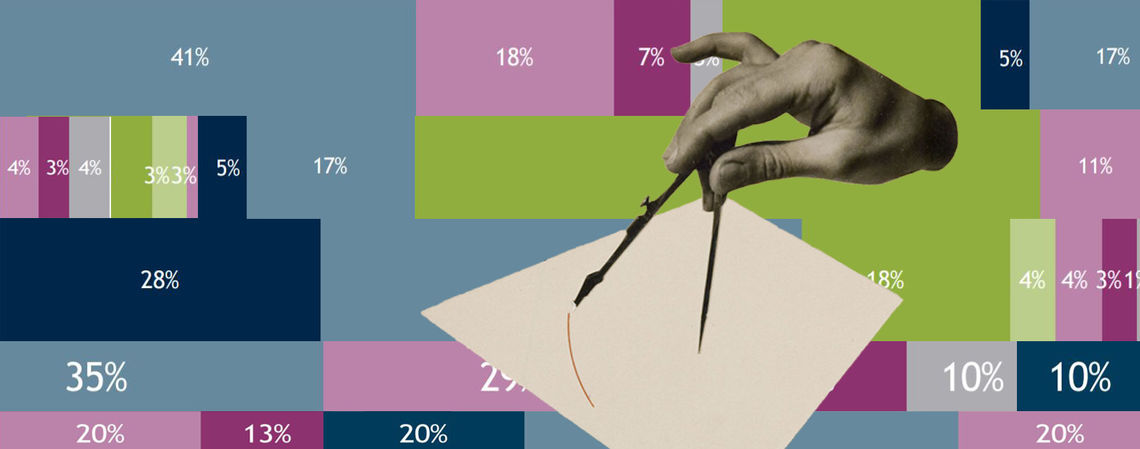
For a society that has become conditioned to perpetual economic difficulties, to put it mildly, the specter of financial and monetary concerns has haunted the socio-economic psyche of the Armenian citizen. Accustomed to a climate of economic deprivation, much of Armenian society had come to accept a new normal: living in continuous survival mode. This economic reality, needless to say, became crystallized as the dominant political issue for the Armenian citizen. That the Velvet Revolution brought about a new era of hope and optimism did, to some extent, alter the collective trauma induced by economic stagnation. Indeed, the Velvet Revolution ushered in its own new normal: confidence in the country’s economic future. This optimism, however, is not economic; it is purely political. It is confidence in the post-Velvet Revolution government of Prime Minister Pashinyan. A recent prominent poll by the Washington-based and USAID-funded International Republican Institute (IRI) primarily reifies this point: while the Armenian citizen continues to have important economic concerns, they are mitigated by the citizens’ trust and confidence in the Government.
The Direction of the Country and Economics
Over the past several years, issues that impacted Armenians’ personal pocketbooks have triggered widespread protests on several occasions. In 2011, a ban on street vending lit the spark for protests that snowballed to include more general anti-government grievances. In 2013, a proposed public transportation fare increase led to widespread disobedience, where passengers would refuse to pay the new, higher fares (which were eventually reversed). In 2014, changes to the pension system and then-President Sargsyan’s announcement that Armenia would join the Eurasian Economic Union caused two separate rounds of protests. The most memorable of these precursors to the Velvet Revolution, however, was the Electric Yerevan movement in 2015, which ultimately led to the sale of Armenia’s electricity distribution company by its Russian corporate owner, after a proposed 17% price hike.
In post-Velvet Revolution Armenia, such economic concerns have not subsided, as the IRI poll clearly confirms. The poll, published on December 9, was conducted in September and October 2019, before the Parliament finalized a 23.6% increase to the minimum wage, from 55,000 AMD/month to 68,000 AMD/month. The new rate[1] is effective January 1, 2020, coinciding with the adoption of the new flat income tax regime. It will impact 57,000 public sector workers and 130,000 private sector workers. Such economic indicators, however, remain limited in explaining the overall euphoria that has sustained itself after the Velvet Revolution, along with the Pashinyan Government’s unprecedented ability to remain extraordinarily popular.
In comparison to the prior IRI survey conducted in May 2019, the October poll shows 62% of Armenian society holds the view that the country is heading in the right direction, while the previous survey showed 60%. The 2% increase is not as important as the continuous optimism of society: time is not taking a toll on the citizens’ positive trajectory for the country. Compared to the high euphoria of 2018, where 73% viewed the country as heading in the right direction, a mere 9% decrease, over a time span of a year and a half, is quite telling of the relative shift in Armenia’s political culture. Armenia is no longer a pessimistic society. This premise is further supplemented by the response to the following question: How would you evaluate the prevailing mood of the Armenian population? Collectively, 70% displayed optimism that the future will be “better;” this is a minor increase from 69% in the May 2019 survey.
This collective optimism, as noted, is not driven by economic indicators but by political indicators. When addressing the question on the “biggest success” of the Pashinyan government, the top three responses were: 1) decreased corruption; 2) improved psychological state of the people; and 3) advancement of democracy. Similarly, when asked what the “biggest failures” of the government were, the top three responses were: 1) bad management; 2) unfulfilled promises; and 3) perceptions of political instability. Economic concerns ranked fourth behind these indicators. The underlying assumption is that, even when gauging the perceived “failures” of the new government, Armenian society is not ready to blame them for their economic concerns. The Prime Minister’s political popularity is quite easily subduing, at this stage, any serious backlash on economic matters.
Prospectively, however, the expectations of citizens are heavily indicating potential economic accountability. The poll asked Armenian residents what they thought the government “must achieve in the next six months,” and the top three responses were unequivocally economic: 1) create jobs; 2) solve socio-economic problems, and 3) increase wages. Even the fourth response was socio-economic: increasing pensions. These expectations are also uniquely qualified in the survey by the perceived patience of citizens. When addressing the question “should economic reforms be undertaken quickly or more gradually,” 75% of respondents voiced the need for much quicker implementation of reforms. Compared to May 2019, where the affirmative response was 63%, a 12% discrepancy is noticeable: citizens are becoming observably more impatient with time and the demand for quicker implementation of reforms is increasing.
There does appear to be, however, a fascinating disconnect between the general optimism of citizens and their personal economic situation. When responding to the question concerning Armenia’s economic situation over the last six months, 50% of respondents noted improvement, with 36% not seeing any changes, and 13% saying that things have actually gotten worse. In the May 2019 survey, 42% noted improvement, 35% stagnation, and 18% argued things were actually worse. In this context, the positive trajectory has increased by 8%; perceptions of stagnation have primarily stayed the same; while perceptions of things being worse has actually dropped by 5%. Collectively, a majority of Armenians view the economic situation in the country to be improving, with only a marginal amount arguing decline.
These relatively positive outputs, however, are interestingly disconnected when the economic questions are answered on a micro, personal basis. When asked about the financial situation of one’s household over the last six months, the overall numbers indicate more of a stagnation than improvement. While 30% responded that there was improvement in their household, 55% responded that their situation had “stayed the same,” while 15% responded things had worsened. Compared to the May 2019 numbers, slight progress is observable: household improvement is noted at 24%, stagnation at 58%, and worsening at 17%. Collectively, the economic situation in Armenian households, over the last six months, has improved by 6%, while perceptions of stagnation have slightly dropped by 3%. Perceptions of household economic deterioration also declined by 2%. In this context, even a micro-level assessment notes slightly positive responses. However, at the same time, the overall pocketbook concerns of citizens remain front and center. When asked what the “main problems Armenia is currently facing” are, the number one was response was “unemployment/jobs.” When posing the question at the local level (towns or villages), the number one response was the same: “unemployment/jobs.” With respect to the specific problems faced by households, all top three responses were economic hardship: 1) financial problems; 2) housing; and 3) unemployment.
But when comparing citizens’ micro perception of their household to the country’s macroeconomic situation, a disconnect is observable: while people have important economic concerns in their households, they still view the overall economic situation in the country to be consistently improving. This positive perception, perhaps finds support in citizens’ overall economic situation, and not simply in the last month 6 months. When asked how one would “describe the current economic situation” of one’s household, the numbers appear to be quite consistent, even better, than the national outlook. 63% of respondents noted that their current household economic situation was good, while 33% claimed it was bad.
Over the last six months, the financial situation of your household has...
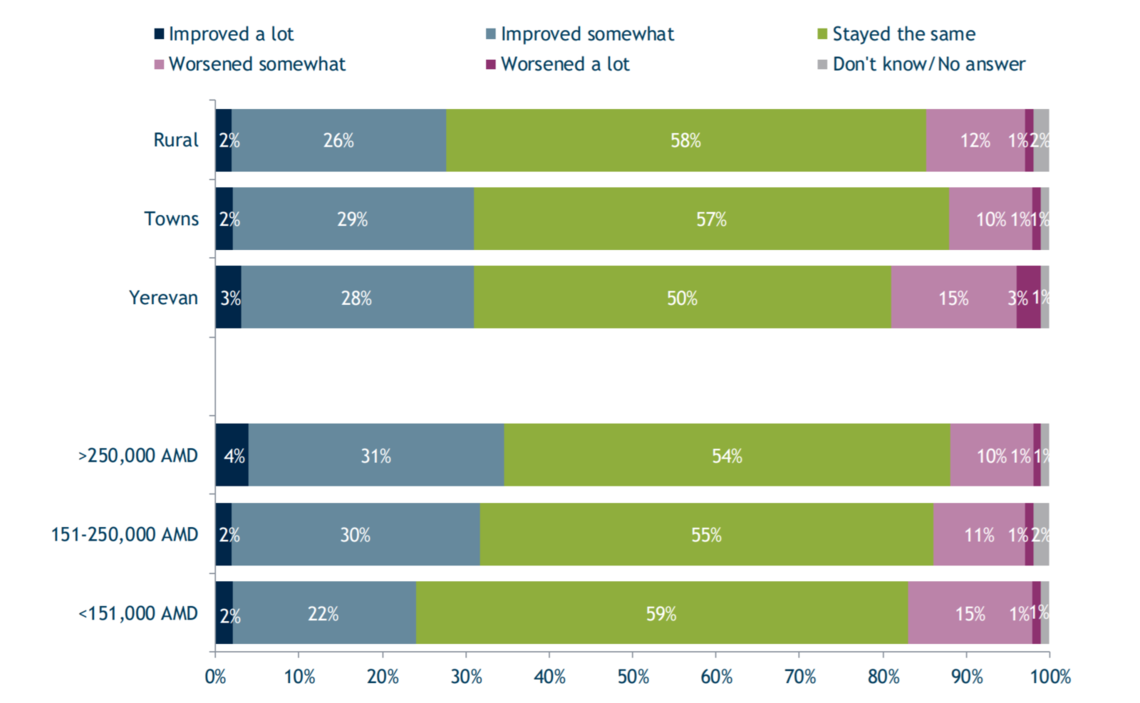
Socio-Political Issues and Institutional Trust
The survey indicates several socio-political trends and growing institutional trust, which are important indicators of Armenia’s burgeoning democratic culture and social inclusiveness. In gauging the importance of including women, youth and the disabled in political decision-making, 64% of respondents noted that including youth was “very important,” while another 28% said it was “somewhat important,” thus demonstrating 92% approval of youth inclusiveness in political decision-making. Similarly, 54% responded “very important” to including people with disabilities in political decision-making, while 38% responded “somewhat important,” producing a healthy 92% approval. The numbers for the inclusion of women in political decision-making were also similar, with 54% responding “very important” and 37% “somewhat important.” This is consistent with responses to questions pertaining to “violence against women,” with 76% noting that they “strongly agree” that it is “unacceptable” and perpetrators should be punished by law, while 20% “somewhat agreed.” Collectively, 96% of Armenian society displayed disapproval of violence against women and supports the need for punitive action by the state. On the issue of combating discrimination against women, 61% strongly agreed, with 29% “somewhat agreeing;” again, an over-90% support to abolish discrimination. On the ideational issue of women’s “inferiority,” 49% strongly agreed that the state should “eradicate prejudices and all other practices which are based on the idea of the inferiority of women to men,” 36% “somewhat agreed,” indicating 83% support in Armenian society to alleviate the precept that women are inferior to men. Collectively, the numbers indicate robust support for social inclusiveness, as well as alleviating cultural and institutional sexism.
On the issue of institutional trust, which is a vital component of democratic consolidation, the survey’s favorability ratings are a healthy proxy to gauge the public’s approval and trust of Armenia’s state institutions. Armenian society’s approval and trust of the Army remains unmatched, with favorability at 91%. This is a 10% increase from the May 2019 survey, indicating that the government’s military reforms are bearing fruit. The second-most favorable institutional rating, at 82%, is the President’s Office, confirming the widely-held view that Armen Sarkissian’s stewardship of the Office has become synonymous with seniority and dignified statesmanship. The Office of Prime Minister displays a 76% favorability rating, an astronomical number for a parliamentary democracy and further confirmation of Nikol Pashinyan’s immense political capital and public trust. In comparative terms, the assumption that PM Pashinyan was enjoying a “honeymoon” period is negated here; in the May 2019 survey, the Prime Minister’s favorability rating was 72%. In this context, not only has PM Pashinyan’s favorability sustained itself, but it has increased by 4%.
A similar trend is also observed with the Armenian Apostolic Church. The Church’s favorability has increased from 71% in the May survey to 74%, an important indicator of the Church’s extremely strong base. Considering the on-and-off tensions between the Church and the government, and at times the disconnect between the popular PM and the Church, Etchmiadzin’s high favorably is indicative of its autonomous support base and the institutional legitimacy of the Armenian Apostolic Church. A consistent showing of favorability is also noted with the National Assembly: in both surveys, its favorability is in the 62-63 percent range, obviously indicating a healthy degree of satisfaction by citizens of its elected representative body.
On the reverse side of the discourse, the state institutions with the least trust are the bottom three: the Constitutional Court with 51% unfavorable rating, the Prosecutor’s Office with 55% unfavorable, and the Courts (judicial system), being the least trusted institution with 57% disapproval. While distrust and disapproval of the judicial system has been consistent in most polls, the interesting finding here is that the much-maligned Constitutional Court is actually more popular (or less unfavorable) than the Prosecutor’s Office. This is an interesting dynamic because the Prosecutor’s Office is perceived as an ally of the Prime Minister’s Office; however, it is evident that the PM’s popularity has not leaked over to the Prosecutor’s Office. Further, it appears that public distrust towards the country’s legal system is holistic: both prosecutors and judges are simply not trusted by Armenian society.
Please tell me your opinion about the work of each of these institutions:
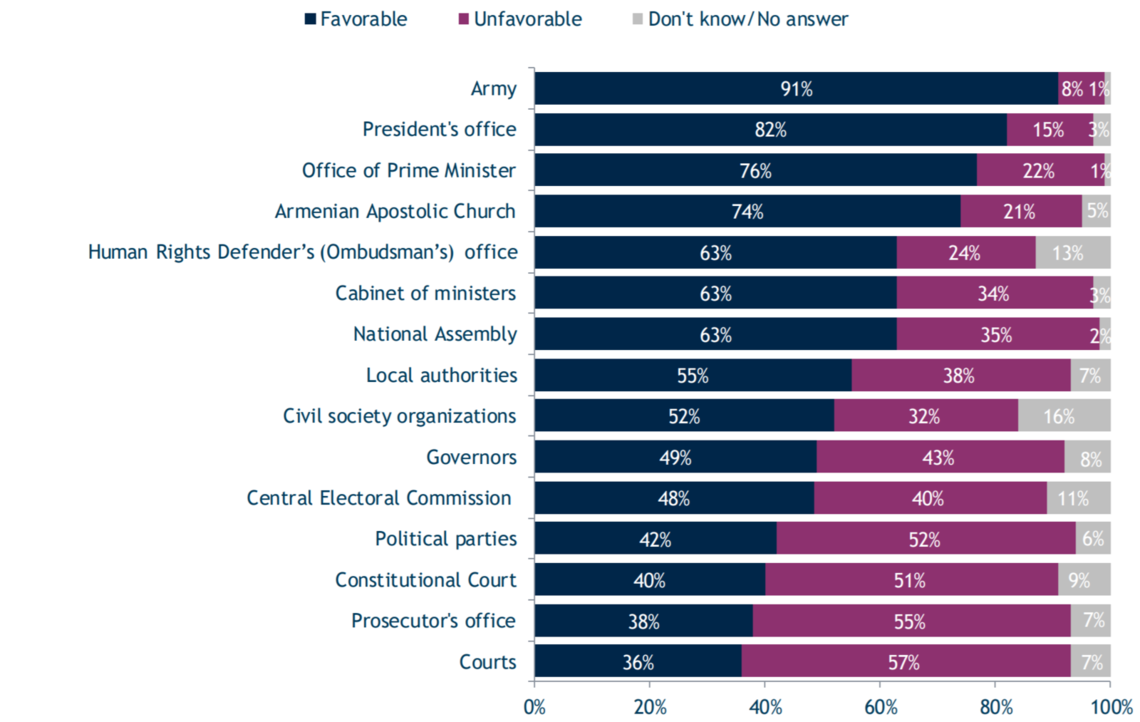
The Prime Minister’s Anti-Corruption Campaign and His Ever-Increasing Political Capital
That being said, the public’s attention has been more on judicial reforms than on other institutional changes. In a broader sense, the pubic equates judicial reforms with the fight against corruption. That the Prime Minister leads the fight has immensely shaped the public’s perception of the process. 48% of respondents noted that reforming the judiciary is a “top priority,” while 34% considered it “important but lower priority.” Contextually, 81% of Armenian society considers judicial reforms as important. Stephen Nix, the IRI Regional Director for Eurasia, commented that the Armenian public seems largely satisfied the government’s fight against corruption and are ready to grant them a strong mandate to implement judicial reform. This is evident in the public’s perception of government efforts to combat corruption. 66% reported that “enough effort” is being made by the Government to combat corruption, while only 29% noted “not enough” is being done. The Government’s message appears to be resonating, considering the response to the same question in May was 59% “enough effort” to 31% “not enough effort.” This increase of public satisfaction in the fight against corruption dovetails with the increasing political capital of the Prime Minister; the image of Pashinyan as an anti-corruption crusader is clearly delivering political dividends. The response to the question on the effectiveness of combating corruption demonstrates this point: 31% of Armenian society considers the government’s fight as “very effective,” while 39% considers it “somewhat effective.” Collectively, 70% of the Armenian public deems the Government’s anti-corruption crusade as effective.
This effectiveness, however, is not insulated from specific concerns when gauging institutional nuances and perceived levels of corruption. As far as public perception is concerned, the most corrupt governmental service provider is not the Courts, but rather, medical services. This is a new and interesting development. 20% of respondents noted medical services to have “a lot of corruption;” 43% asserted “some corruption,” while 20% addressed “little corruption.” Collectively, 83% of Armenian society confirms some degree of notable corruption in the country’s medical services. This is much higher than the collective notable level of corruption with the courts (72%), tax services (69%), and higher education/universities (62%). The analytical considerations here are quite clear: the Armenian public’s perception of the fight against corruption is shaped more by the publicized National Security Service’s (NSS) arrests of oligarchs and former officials than it is by broad-ranging institutional reforms. While the public considers the Government’s efforts as being relatively sufficient and effective, these perceptions appear to be shaped more by the Government’s narrative than actual output. The Government has done an impressive job of publicizing its anti-corruption efforts. When respondents were asked if they had “heard of any anti-corruption efforts of the government or National Assembly,” the confirmation rate was 58%. In relation to the May 2019 poll, only 49% of the population had heard of the government’s anti-corruption efforts. This 9% increase in awareness is indicative of the government’s success in communicating with the public on the issue, and as such, shaping the narrative.
I will read you a list of institutions and government service providers. Please tell me about the level of corruption for each?
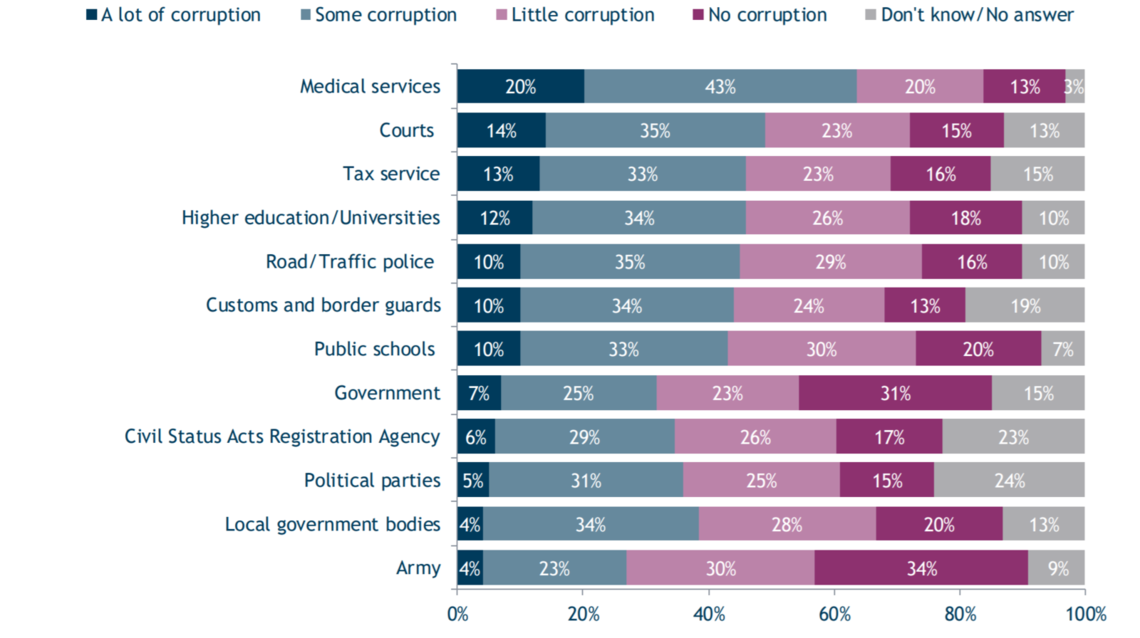
The Economics and Politics of International Relations
Respondents “evaluated” four countries as having extraordinarily good relations with the country, with 94% recognizing Georgia, 93% China, 93% Iran, and 93% Russia. The European Union was evaluated as “good” by 91% of respondents, while the United States 88%. These general remarks, however, become more interesting when observing the nuanced responses to economic and political issues. When asking which “countries do you consider the most important economic partners or threats for Armenia,” two countries stand out: Russia and Georgia. Russia was ranked as the most important economic partner by 72% of respondents, followed by Georgia at 60%. The more telling response, however, was the evaluation of “threat.” 19% of respondents viewed Russia as an economic threat to Armenia, while 15% viewed Georgia as such. In threat level, Iran garnered 10%, United States 6%, China 3% and the European Union 2%. Contextually, Armenians considered their most important economic partner to also be their most threatening economic partner, an interesting indicator of latent distrust against these regional partners.
When the same question is posed through the political sphere, the evaluation rankings are quite different. 88% of Armenians consider Russia as the most important political partner, followed by the European Union at 41%, the United States at 39%, Georgia at 37%, Iran at 39%, and China at 22%. Analytically, three points are quite clear: 1) Russia is considered as both the most important economic as well as political partner; 2) the U.S. and E.U. are considered important political partners, but less relevant economically; and 3) Georgia, China and Iran are viewed as important economic partners, but less politically relevant. But more important to this analysis is the ranking of the political threat factor: Russia also remains politically the most threatening partner Armenia has. The second ranking in threat falls to the United States at 8%, while Georgia garners a mere 3%, with Iran, China and the European Union at 1 or 0 percent. Conceptually, whereas Georgia, for example, is viewed as an economic threat, it is not deemed politically threatening; similarly, whereas the United States is viewed politically threatening, it is not deemed economically threatening. The one partner that represents both an economic and political threat remains Russia; also ranked as the most important partner in both spheres. The general perception, then, is quite obvious: Russia looms quite large over Armenia, both politically and economically. But, just as importantly, the level of positive response toward the Russian partnership is extraordinarily high. The fear that Russia might interfere, obstruct or create serious complications for post-Velvet Revolution Armenia has, to a large extent, subsided. Russia, it appears, has played its hand right: the Armenian public, whether due to gratitude or sheer pragmatism, views Russia as an important and positive partner.
How would you evaluate the current state of the relationship between Armenia and the following countries?
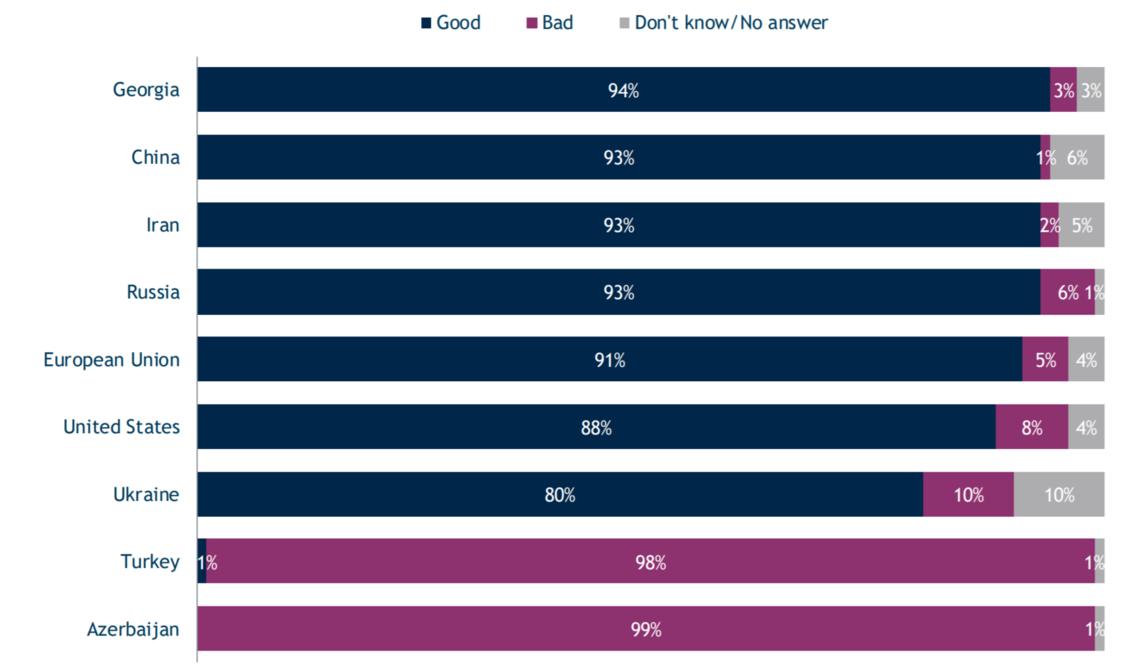
Which of these countries do you consider the most important economic partners or threats for Armenia?
(Multiple responses permitted)
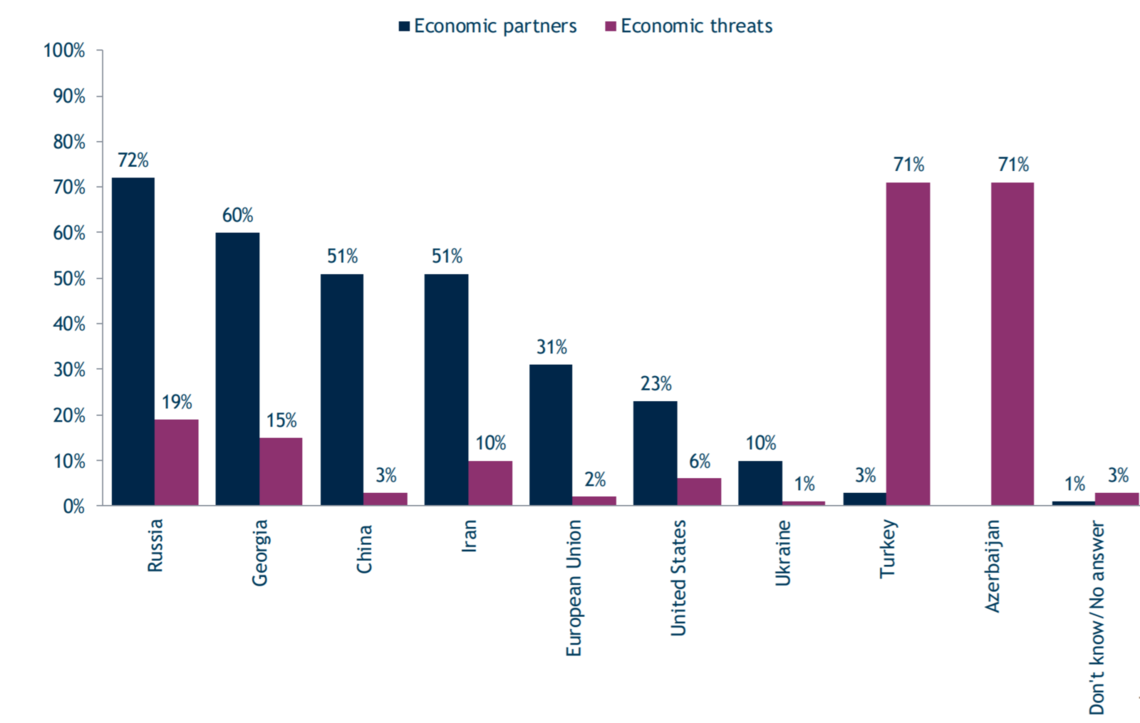
Conclusion
In general, Armenians know that there are still many issues to resolve but remain confident that the country, under its current leadership, will make great strides. This attitude provides a broad mandate to the Pashinyan government to implement deep reforms. It would be incumbent upon them to keep the tangible impact on the average citizen’s pocketbook in mind.
-----------
1 - The vote in Parliament to enact the increase was accepted with 104 votes in favor and none against.
Source: IRI (used with permission).
We are pleased to open up a comments section. We look forward to hearing from you and wish to remind you to please follow our community guidelines:
EVN Report welcomes comments that contribute to a healthy discussion and spur an informed debate. All comments will be moderated, thereby any post that includes hate speech, profanity or personal attacks will not be published.
Comments
Rafael Oganesyan
12/12/2019, 7:19:52 PMThis is a well-written and informative work. My one point of contention is with the notion of a "honeymoon period." First, there exists some debate as to the length of a "honeymoon period." Interestingly, popular media alludes to the high popularity function lasting a few months, while scholarship asserts a longer time horizon (e.g. Copeland 1983; Lockerbie et al. 1998). Second, one could argue that the "honeymoon period" is prolonged in developing democracies, especially when someone ascends to the premiership following a sudden popular uprising. Compared to western societies, voters have increased "political tolerance" of the executive. This is why in the US, the president's party most certainly loses congressional seats during the midterms. The "referendum model" (see. works by Ed Tufte - Particularly Tufte 1975) suggests that the midterm vote function is largely impacted by the popularity of the President. In short, it is a referendum on the president. In Armenia, following years of systemic depletion of the country's resources and a deliberative effort to create a population exodus, it would be irrational for the median Armenian voter to cease support for Pashinyan. Thus, Pashinyan is still in a honeymoon period. Finally, if we are to predict the end of Pashinyan's "honeymoon" with the Armenian voter, we must draw comparisons with Georgia (or even Ukraine). Saakashvili saw issues in his popularity more than two years into his tenure. Thus, Armenians will continue to have patience with Pashinyan and he will have a prolonged honeymoon period (as expected). But in 2-3 years, unless pocketbook perceptions improve, Pashinyan will witness a dramatic drop in popularity. In all, Pashinyan "was [not only[ enjoying a honeymoon period..." he still is!


